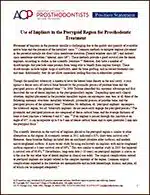
disadvantages that preclude some patients from being able to benefit from implant therapy. These disadvantages include higher surgical morbidity, need for bone grafting, and increased treatment cost and time. Additionally, they do not allow immediate loading/function in edentulous patients. READ STATEMENT
Use of Implants in the Pterygoid Region for Prosthodontic
Treatment, Position Statement, American College of Prosthodontists, June 2017.